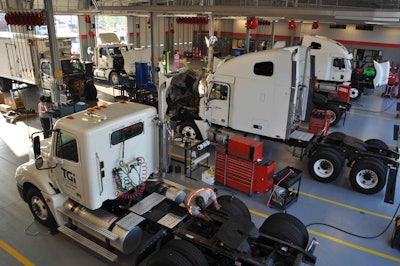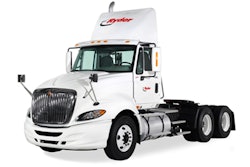
HWT: Talk about tire replacement, including brand management.
Perry: We control the service network, which means that if a tire breakdown event occurs then the customers are calling our Ryder Road Call Response Center. We’re essentially guaranteeing the maintenance call through a full-service lease. We work with an approved network of suppliers that we control and then they’re taking our inventory in a lot of cases out to do the road call or it’s a Ryder shop that’s going out and performing the service event. There are instances where we are in odd markets that may have a gap in coverage. There are a few of those out there that do exist. For instance, in North Dakota there are a couple of places where there’s not a lot of good coverage. Invariably when that occurs, you’ll have a third party vendor who will go out—and we’re still very specific about tire types and brands. But if we’re caught in a situation where we have to take non-primary brand of tire to put on the vehicle to put it back on the road, that’s what we’ll do, but we’ll generally manage that tire out of our network whenever it comes back to our system. First and foremost, we try to maintain all of that service through our preferred and primary service network and control that tire’s spec and that repair event all the way through from beginning to end.
HWT: Just to ensure that I understand correctly, you’re trying to match brands during tire replacement?
Perry: We have one primary brand of tire that we use in our fleet and that’s Bridgestone, from beginning of life and at every retread. It’s the only supplier relationship that we have that is sole sourced. We’re 100 percent Bridgestone/Bandag throughout our entire fleet and that makes it pretty easy for us whenever we’re replacing tires. That’s the only thing we want to put back on and it’s either coming directly from our partner service provider in that local market or one of their affiliates. But it’s always going to be directed toward a Bridgestone tire. We have identified Continental as a secondary backup based upon our testing that we’ve done with them and it is an approved tire, but generally we’re trying to match up like for like.
HWT: Electronic tire monitoring…how important of a role does that play?
Perry: Air inflation, whether it’s checked manually or electronically, is probably the biggest thing that drives even tire wear, long tire life, great fuel economy and helps eliminate breakdowns. The more you can make sure the tire’s inflated, the better you are. We’ve used, and generally have standard on our trailer fleets, the Meritor PSI system for tire inflation.
Perry (con’t): What I’m really looking forward to is some of the technology being developed for automated tire inflation systems on power equipment. Drive tires, steer tires are a little more difficult, but I see that coming as well. That’s also one of the key technologies that’s being outlined in the GHG Phase II emissions requirements, automated tire inflation systems. They’re a key technology that have been identified because they see the benefit from fuel economy and I think there’s going to be some significant advancements made there in the next few years. We’re a big proponent of it but it’s not something that we’ve seen a lot of research and development work around. There’s just a few systems available, but I think we’ll see a lot more people come to the table. It’s going to be something that will likely be part of the compliance plan for a lot of OEMs and leveraging that technology moving forward.
HWT: You mentioned that you use the Meritor PSI system. Are there other auto inflation systems that have caught your attention?
Perry: We have evaluated the Aperia Halo system, which is a pretty unique configuration. We actively use the Meritor PSI system on our trailers, so there’s definitely some good work being done around the development of wheel-end tire inflation technologies that don’t necessarily have to be connected to the onboard air compression system, such as that solution that the Aperia Halo group has developed. It’s a self-contained system. It’s a pretty unique approach and I think they definitely have some great opportunities there for developing that. I think there’ll will be others that will develop similar technologies that either leverage integrated compression systems from the power unit or a self-contained unit of that nature. But there’ll be a lot of benefits that come from much greater and consistent tire wear and fuel economy that will come from that. You can go out and audit a fleet and the tire inflation will be all over the board. In our world, if it’s more than 10 pounds, or 10 psi, off our targeted inflation, depending upon the wheel position, we consider that to be a flat tire. It means that it has to be removed from the vehicle and inspected to determine why we had such a variance in tire inflation. But if you go look at a non-Ryder fleet and start checking tire inflation, the wheel position, the variability will be significant. That’s one of the reasons why we see so many tire failures out there in the marketplace.
HWT: Have you used Halo (auto air inflation systems) in the field?
Perry: We’ve done some limited testing. I know a number of fleets out there that have made a major conversion and added it to their fleets. We’ve done some limited testing, and the overall performance is good, and we’ll evaluate that along with some of the other tire systems that are being developed or are available and make a determination as far as which one makes the most sense. I think what we’ll see is that a lot of the chassis manufacturers will be developing technology, integrating technology for something that’s installed at the point of production as opposed to more of an aftermarket application as far as GHG Phase 2. So, I think there’ll be a lot of activity in this space over the next couple of years.
Look for Ryder talks tires as new regs approach, part III tomorrow.









